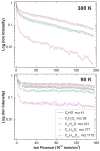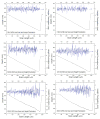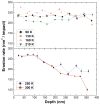Cluster secondary ion mass spectrometry and the temperature dependence of molecular depth profiles
- PMID: 22455606
- PMCID: PMC3341538
- DOI: 10.1021/ac2032589
Cluster secondary ion mass spectrometry and the temperature dependence of molecular depth profiles
Abstract
The quality of molecular depth profiles created by erosion of organic materials by cluster ion beams exhibits a strong dependence upon temperature. To elucidate the fundamental nature of this dependence, we employ the Irganox 3114/1010 organic delta-layer reference material as a model system. This delta-layer system is interrogated using a 40 keV C(60)(+) primary ion beam. Parameters associated with the depth profile such as depth resolution, uniformity of sputtering yield, and topography are evaluated between 90 and 300 K using a unique wedge-crater beveling strategy that allows these parameters to be determined as a function of erosion depth from atomic force microscope (AFM) measurements. The results show that the erosion rate calibration performed using the known Δ-layer depth in connection with the fluence needed to reach the peak of the corresponding secondary ion mass spectrometry (SIMS) signal response is misleading. Moreover, we show that the degradation of depth resolution is linked to a decrease of the average erosion rate and the buildup of surface topography in a thermally activated manner. This underlying process starts to influence the depth profile above a threshold temperature between 210 and 250 K for the system studied here. Below that threshold, the process is inhibited and steady-state conditions are reached with constant erosion rate, depth resolution, and molecular secondary ion signals from both the matrix and the Δ-layers. In particular, the results indicate that further reduction of the temperature below 90 K does not lead to further improvement of the depth profile. Above the threshold, the process becomes stronger at higher temperature, leading to an immediate decrease of the molecular secondary ion signals. This signal decay is most pronounced for the highest m/z ions but is less for the smaller m/z ions, indicating a shift toward small fragments by accumulation of chemical damage. The erosion rate decay and surface roughness buildup, on the other hand, exhibit a rather sudden delayed onset after erosion of about 150 nm, indicating that a certain damage level must be reached in order to influence the erosion dynamics. Only after that onset does the depth resolution become compromised, indicating that the temperature reduction does not significantly influence parameters like ion-beam mixing or the altered-layer thickness. In general, the wedge-crater beveling protocol is shown to provide a powerful basis for increased understanding of the fundamental factors that affect the important parameters associated with molecular depth profiling.
Figures






References
Publication types
MeSH terms
Substances
Grants and funding
LinkOut - more resources
Full Text Sources
Miscellaneous

